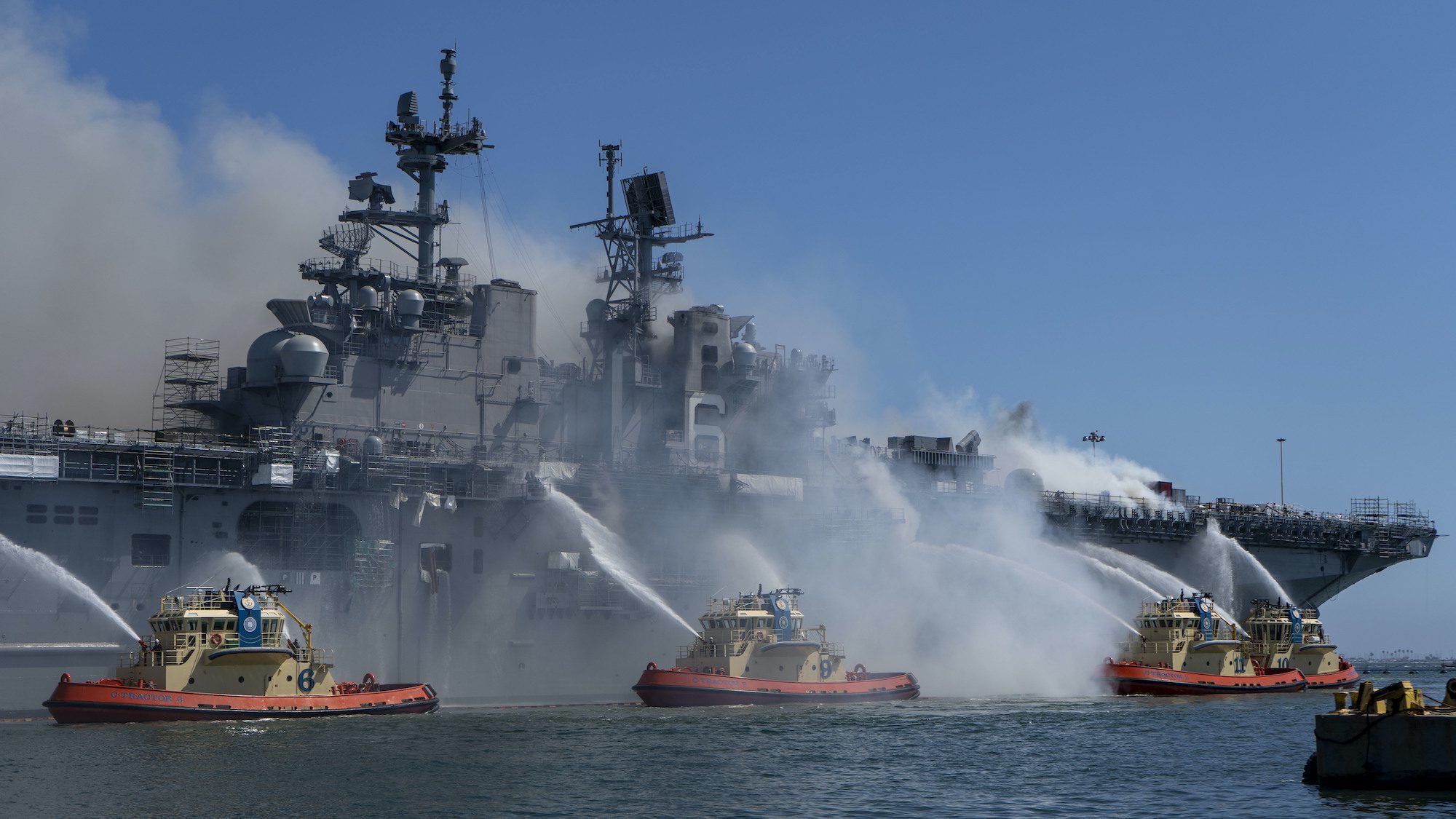By CW4 Michael Carr, US Army Watercraft Master (Retired)
“A guy with a flag simulates a flame, and a nozzleman says…I am squirting you with water…and then they say…fire is out.”
This statement by a Navy sailor is found in the recently released Navy report on the USS Bonhomme Richard fire and typifies how many of the firefighting drills were conducted for the crew before the catastrophic fire, lasting five days, destroyed the ship in July 2020.
In addition to poorly run and deficient drills, many of the ship’s crew had not donned Self- Contained Breathing Apparatus (SCBA) in over a year, did not know how to use or activate Aqueous Film Forming Foam (AFFF) or halogenated hydrocarbon (Halon) firefighting systems, and were unaware of where to locate and use Emergency Escape Breathing Apparatus (EEBA).
There was no “map of the ship” (Fire Control Plan as required by IMO SOLAS convention) available to shoreside firefighters when they arrived at Pier 2 at the San Diego Navy Base to assist in the firefighting effort. And there were no fire standpipes on the pier to supply firefighting water.
As the fire aboard the 844 ft LOA, 27,000-ton Wasp Class Amphibious Assault Ship grew, temperatures reached over 1400 degrees F, melting her aluminum internal superstructure. Rapidly, the fire engulfed nearly the entire ship, enabled by chaos and confusion.
Mismatched hose threads, lack of compatible radios and common frequencies, inability to locate the fire, inability to provide firefighting water, no SCBA refilling capability, portable pumps inoperable, dead batteries in equipment, inability to accurately account for all crew, inability to take correct draft readings (required for stability calculations), not accounting for free surface effect, and a “leadership vacuum”. These are just a few of the issues identified in the US Navy’s report.
Upon reviewing the recently released 434-page US Navy report on the USS Bonhomme Richard fire, I am saddened by the multitude of identified needless errors, as well as the realization that possibly our vulnerabilities as a military are not threats from Russian hypersonic missiles or North Korean nuclear bombs, but ourselves.
Our military bureaucracy has become so complicated and filled with incomprehensible manuals and flowcharts that we are now disconnected from the critical need for mastering the basic skills needed to be an effective maritime professional. Firefighting is just one of many skills that all mariners must embrace, in addition to marlinspike seamanship, damage control, ship handling, stability, and small boat operation.
As a Coast Guard-approved Basic and Advanced Firefighting Instructor, I have led hundreds of mariners through live-fire training, attacking and extinguishing fires fueled by propane, gasoline, diesel fuel, aviation fuel, wood, and electrical sources. Firefighting requires combat skills, where the enemy (fire) is ruthless and ingenious. Temperatures exceeding 1500 F bring flashovers, explosions, and reflashes when you naively believe a fire is out. Fires will flashback and consume everything in its path. Only rapid action, aggressive tactics, tenacity, expert training, and experience brings success. You cannot simulate fighting a shipboard fire, you must fight a real fire in training to grasp the skill necessary to succeed in an actual event.
Firefighting demands fearless leadership, not wardroom leadership. Boots on the ground, where rapid assessment of a situation initiates a swift response. An incipient fire develops exponentially, and if not attacked and contained within minutes will quickly become a fully engaged fire, producing temperatures over 500 F, igniting everything within its surroundings.
Technology has deluded us into believing shipboard fires are no longer a threat. Ubiquitous alarms, complicated fire control systems, and distractions make fire prevention a non-priority. Reviewing the USS Bonhomme Richard fire report shows priorities were placed on completing repairs on time, managing an overwhelming amount of shipyard work, with many projects conflicting. Bonhomme Richard had been in the shipyard for over a year when this fire occurred, and there existed a plethora of shipyard projects, dismantled systems, and confusing priorities. Her crew suffered from a lack of clear leadership and direction.
Shipboard fires are terrifying; they are the most significant threat to a ship. Well-trained crews keep their ships scrupulously clean, bilges free of oil and grease, trash receptacles emptied before they become full, electrical systems monitored, alarms checked, and a constant roving watch using their sense of sight, smell, hearing, touch, and well-honed training to detect threats which can be remedied immediately.
Loss of the USS Bonhomme Richard was due to a fire; but the fire occurred due to a preponderance of failures within our culture for identifying priorities and caring for our Sailors and ships. The fire was small when an arsonist started it and had it been detected early, could have been extinguished. Bonhomme Richard was lost because we have lost touch with the basic skills and professional focus needed to be maritime professionals. We are managing ships as if they are floating office buildings. Our leaders need to reclaim the importance of inculcating the fundamental proficiencies which define being a Maritime Professional.
Chief Michael Carr is a retired US Army Marine Warrant Officer. He holds a USCG Third Mate Unlimited and 3000 GT All Oceans CG License, and a US Army All Oceans Watercraft License. He is a US Navy trained Ship Salvage Diving Officer and, prior to joining the US Army, served in the US Merchant Marine and US Coast Guard.
Sign up for our newsletter

 Join The Club
Join The Club











